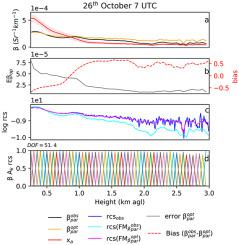Atmospheric Environment ( IF 5 ) Pub Date : 2021-02-06 , DOI: 10.1016/j.atmosenv.2021.118243 A.E. Bedoya-Velásquez , Romain Ceolato , Sidonie Lefebvre

|
The solution of the lidar equation is an ill-posed problem that requires nonlinear methods to retrieve the atmospheric aerosol optical and microphysical properties. Particularly, in the last decades, the most applied solution for the elastic lidars is through the well known Klett-Fernald-Sasano algorithm for retrieving the backscatter coefficient. To solve this inversion problem, we propose to apply the optimal estimation method to a Vaisala CL51 ceilometer range corrected signals for retrieving under two different frameworks, the particle backscatter coefficient or the ratio and the lidar constant. The optimal estimation is a Bayesian inversion fed by a set of a priori information. In this work, to obtain the suitable prior, we have tested two approaches that involved measurements and synthetic data. The first data set was obtained from previous inversions using the classical Klett-Fernald-Sasano method, and the second one by using Mie simulations fed by aerosol properties from OPAC database.
The optimal estimation method used for elastic lidar inversion presents two main advantages compared to the classic approaches. On one hand, there is no need for Rayleigh zone determination and on the other hand, the uncertainty of the retrieved products is directly estimated, therefore the quality of the results is highly dependant on the prior selection. To evaluate the performance of the model, low and high aerosol accumulations scenarios were considered, finding that the backscatter coefficient was oscillating between 5 and 7 (kmsr)−1 in the first 3 km agl with uncertainties lower than 27 at degraded spatial resolutions. Additionally, constant and height-dependent priors were tested reaching relative errors in percentage up to 5 between them. Besides, relative errors were also analyzed for the prior covariance matrices estimated either from synthetic lidar data and Klett's retrievals, where the errors are lower than 2 by using one instead of the another. However, scale factors were applied to the synthetic prior covariance matrices to reach the convergence.
The results at retrieving the particle backscattering were compared to those ones estimated from Klett's inversion, considering Klett inversion as the reference. For the extreme scenario of inversions, considering aerosol accumulations at different layers, the bias between the optimized profiles was lower than −0.5 (kmsr)−1 in the first 0.5 km and 0.5 (kmsr)−1 above 1.5 km. Here, we also shown a two-parameter optimization for the lidar constant and lidar ratio, applied to 39 aerosol inversions, finding relative errors lower than 1 and 2.3 , respectively, considering those ones from Klett inversion as the reference.
中文翻译:

在云高仪气溶胶反演中的最佳估计方法
激光雷达方程的解是一个不适定的问题,需要非线性方法来检索大气气溶胶的光学和微物理特性。特别地,在最近的几十年中,弹性激光雷达最常用的解决方案是通过众所周知的Klett-Fernald-Sasano算法来获取反向散射系数。为了解决该反演问题,我们建议将最佳估计方法应用于Vaisala CL51云高仪测距校正信号,以便在两个不同的框架(粒子反向散射系数或比率和激光雷达常数)下进行检索。最佳估计是由一组先验信息提供的贝叶斯反演。在这项工作中,为了获得合适的先验,我们测试了两种涉及测量和综合数据的方法。
与经典方法相比,用于弹性激光雷达反演的最佳估计方法具有两个主要优点。一方面,不需要瑞利区的确定,另一方面,直接估计所获取产品的不确定性,因此结果的质量高度依赖于先前的选择。为了评估模型的性能,考虑了低和高气溶胶积聚情况,发现前3 km agl的后向散射系数在5至7(kmsr)-1之间振荡,不确定度低于27 在降低的空间分辨率下。此外,还对常数和高度相关的先验进行了测试,得出相对误差的百分比最高为5它们之间。此外,还分析了根据合成激光雷达数据和Klett的反演估计的先前协方差矩阵的相对误差,其中误差小于2通过使用一个而不是另一个。但是,将比例因子应用于合成先验协方差矩阵以达到收敛。
以Klett反演为参考,将获取粒子反向散射的结果与根据Klett反演估算的结果进行了比较。对于反演的极端情况,考虑到不同层的气溶胶堆积,优化剖面之间的偏差在前0.5 km内低于-0.5(kmsr)-1,而在1.5 km以上则低于0.5(kmsr)-1。在此,我们还显示了激光雷达常数和激光雷达比率的两参数优化,应用于39个气溶胶反转,发现相对误差小于1 和2.3 ,分别以Klett反演中的那些为参考。



























 京公网安备 11010802027423号
京公网安备 11010802027423号